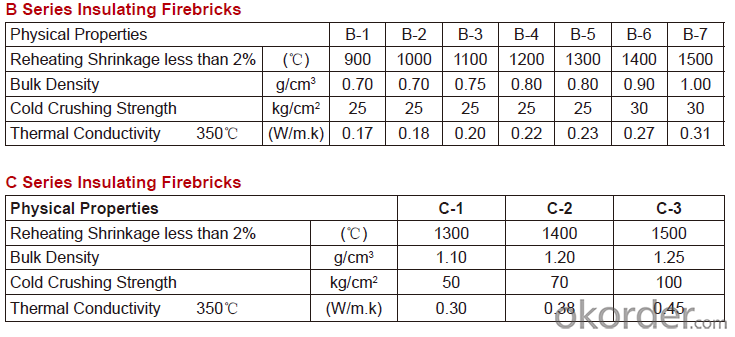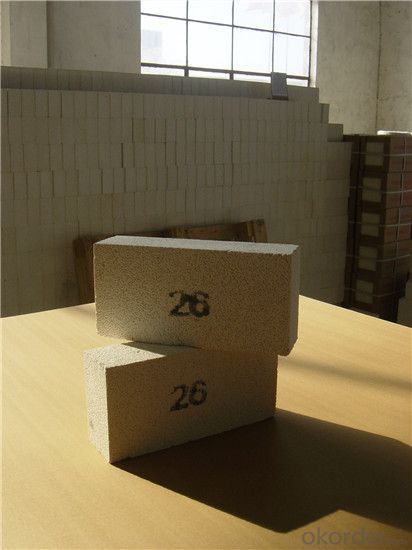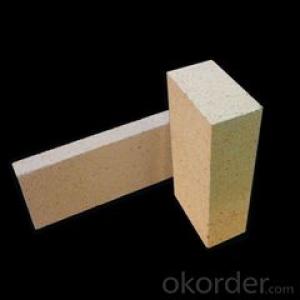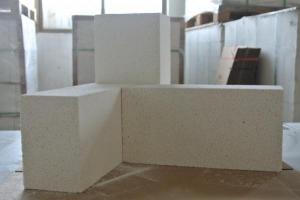Insulating Fire Brick - Far Infrared Heating Fire Clay Insulation Bricks
- Loading Port:
- Shanghai
- Payment Terms:
- TT OR LC
- Min Order Qty:
- 1 m.t.
- Supply Capability:
- 1000 m.t./month
OKorder Service Pledge
OKorder Financial Service
You Might Also Like
Thermal Insulation Fire Clay Brick
Refractory brick is a block of refractory ceramic material used in lining furnaces, kilns, fireboxes, and fireplaces.
We provide high quality Refractory Fire Bricks that are used on wide range in the various industries like Cement, Glass and Steel. Refractory Fire Bricks are provided as per the quantity and specifications required by the customers. We provide an extensive range of Refractory Fire Bricks at reasonable prices that depend upon the quantity ordered.
Application
Insulating Fire Brick are used for the lining of converter, alternating current arc furnace, direct Current arc furnace and the ladle slag line, etc.
Company Advantage
(1)Long Insulating Fire Brick manufacture history: 25 years manufacturer
(2)Advanced equipment
(3)Diversification of production standards: ISO ANSI FEPA JIS ASTM
(4)Flexible payment: T/T L/C D/P D/A
(5)Professional marketing team and after-sale service
Insulating Fire Brick main feature:


Equipment
1 unit of Ceramic Abrasive (SG Abrasive) pilot production line
2 units of Compact grain Abrasive pilot production lines
1 unit of high-end coated abrasives (abrasive cloth) production line
2 units of Boron Carbide production lines
3 large flexible crushing and sieving lines for grit production lines
6 units of 5000KVA-10000KVA dumping type electric arc furnaces for Brown Fused Alumina fusion
Q1 What’s the transport method?
A1 FCL delivery goods with wooden pallet or wooden case by sea; If LCL delivery, must with wooden case; Sometimes need open top, flat rack or bulk cargo.
Q2 What’s the required payment term?
A2 Generally 30% TT as the prepayment, 70% TT before delivery. If need, 100% Irrevocable Letter of Credit or negotiation.
Q3 Which country are our products exported to?
A3 Apart from entire Chinese market, the US, Russia, Japan, Korea, Australia and some Southeast Asian Nations.


- Q: What are the safety precautions when working with insulating fire bricks?
- To ensure the safety of yourself and others when working with insulating fire bricks, it is crucial to follow various safety measures. Consider the following key precautions: 1. Personal protective equipment (PPE): Protect yourself by wearing suitable PPE, such as heat-resistant gloves, long-sleeved clothing, safety goggles, and a respiratory mask. These items will safeguard you against potential burns, cuts, and the inhalation of harmful dust or fumes. 2. Adequate ventilation: Work in a well-ventilated area or utilize local exhaust ventilation to minimize exposure to dust and fumes that may be released during the handling or cutting of the bricks. 3. Fire prevention: Keep a fire extinguisher close by and ensure that the workspace is free of flammable materials. Although insulating fire bricks are highly refractory and can withstand high temperatures, it is still crucial to prevent accidental fires. 4. Proper lifting techniques: As insulating fire bricks can be heavy, employ correct lifting techniques and avoid overexertion to prevent strains or injuries. If necessary, use mechanical aids like trolleys or lifting equipment to move the bricks. 5. Cutting and grinding: Utilize appropriate tools in good working condition when cutting or grinding the bricks. This will minimize the risk of accidents or injuries. Pay attention to sharp edges and wear protective gloves to prevent cuts. 6. Temperature control: While insulating fire bricks are designed to handle high temperatures, avoid direct contact with hot surfaces. Use suitable tools or equipment to handle the bricks when they are at an elevated temperature. 7. Storage and handling: Store the bricks in a cool, dry place away from direct sunlight or extreme temperatures. Avoid stacking them too high to mitigate the risk of collapse or toppling. 8. Training and knowledge: Ensure that you have undergone proper training and are familiar with the characteristics and properties of insulating fire bricks. Understand their limitations and adhere to the manufacturer's guidelines for safe handling and usage. By adhering to these safety precautions, you can significantly decrease the likelihood of accidents, injuries, and health hazards when working with insulating fire bricks. Always prioritize safety in any workplace.
- Q: Can insulating fire bricks be used as a lining for kiln cars?
- Yes, insulating fire bricks can be used as a lining for kiln cars. Insulating fire bricks are designed to have excellent thermal insulation properties, which make them suitable for use in high-temperature applications such as kilns. They are capable of withstanding high temperatures without cracking or crumbling, making them an ideal choice for lining kiln cars. Additionally, their lightweight nature makes them easy to handle and install, reducing the overall weight and energy consumption of the kiln. Overall, insulating fire bricks can provide effective insulation and protection for kiln cars, helping to improve their efficiency and longevity.
- Q: Can insulating fire bricks be used in ceramic industry kilns?
- Indeed, insulating fire bricks find utility in the kilns of the ceramic industry. These bricks are specially crafted to endure extreme temperatures and offer insulation within kilns. With their low thermal conductivity, they facilitate the preservation of uniform heat distribution, thus enhancing the efficiency of firing procedures. Moreover, their lightweight nature simplifies their handling and installation in kilns. The bricks' capacity to retain heat and withstand thermal shock renders them an optimal selection for employment in ceramic industry kilns.
- Q: Are insulating fire bricks suitable for use in cement plants?
- Insulating fire bricks are indeed suitable for utilization in cement plants. Crafted from lightweight refractory materials, these bricks are specifically designed to withstand high temperatures and thermal shock. Their low thermal conductivity allows for effective insulation against heat transfer. In cement plants, where the production process generates elevated temperatures, insulating fire bricks can be applied in various ways. For instance, they can be utilized to line the kiln, which subjects raw materials to extreme temperatures in order to produce cement clinker. By possessing insulating properties, these bricks aid in minimizing heat loss and enhancing energy efficiency within the kiln. Moreover, insulating fire bricks can be employed to line the preheater tower and other areas within the cement plant that experience high temperatures. In doing so, these bricks provide both insulation and protection against the intense heat, consequently prolonging the lifespan of the equipment and reducing maintenance costs. Furthermore, the lightweight nature of insulating fire bricks renders them easier to handle and install in comparison to traditional refractory bricks. Consequently, this can save time and labor during the construction or repair of cement plant equipment. On the whole, insulating fire bricks are a suitable option for utilization in cement plants due to their resistance to high temperatures, low thermal conductivity, and ease of installation. Their implementation can contribute to enhanced energy efficiency, equipment durability, and cost savings within cement plant operations.
- Q: Are insulating fire bricks resistant to cracking under pressure?
- Yes, insulating fire bricks are designed to be highly resistant to cracking under pressure. They are specifically manufactured to withstand high temperatures and thermal shocks while maintaining their structural integrity.
- Q: Can insulating fire bricks be used in the construction of refractory linings?
- Yes, insulating fire bricks can be used in the construction of refractory linings. Insulating fire bricks have excellent thermal insulation properties, low thermal conductivity, and high refractoriness, making them suitable for applications where heat retention and energy efficiency are important. They are commonly used in industries such as steel, ceramics, glass, and cement to line kilns, furnaces, and other high-temperature equipment.
- Q: Can insulating fire bricks be used for insulation in flues?
- Insulating fire bricks are specifically designed for high-temperature applications and are commonly used in furnaces, kilns, and other industrial settings. While they are excellent for insulating heat and preventing heat loss in these environments, they are not recommended for use in flues. Flues are subjected to extreme temperatures, corrosive gases, and the potential for soot and creosote buildup. Insulating fire bricks are not designed to withstand these conditions and may deteriorate or crack over time when exposed to the acidic and corrosive gases produced by combustion. For insulation in flues, it is best to use materials that are specifically made for this purpose, such as refractory cement or ceramic fiber insulation. These materials are more resistant to the harsh conditions found in flues and are better suited to provide effective insulation while ensuring the safety and durability of the flue system.
- Q: Can insulating fire bricks be used in blast furnaces?
- Yes, insulating fire bricks can be used in blast furnaces. Insulating fire bricks are designed to withstand high temperatures and provide excellent thermal insulation, making them suitable for lining the walls of blast furnaces. Their insulation properties help to minimize heat loss and improve energy efficiency in the furnace, ultimately enhancing the overall performance and productivity of the blast furnace.
- Q: Can insulating fire bricks be used in wastewater treatment plants?
- Yes, insulating fire bricks can be used in wastewater treatment plants. Insulating fire bricks are designed to withstand high temperatures, making them suitable for use in various industrial applications, including wastewater treatment plants. They are commonly used in the construction of kilns, furnaces, and other high-temperature equipment. In wastewater treatment plants, insulating fire bricks can be used in the construction of incinerators, thermal oxidizers, and other systems that require high-temperature insulation. Their properties, such as high thermal resistance, low thermal conductivity, and excellent insulation capabilities, make them ideal for maintaining the desired temperatures in these systems while minimizing heat loss. Additionally, insulating fire bricks are resistant to chemical attacks, which is important in wastewater treatment plants where various chemicals and corrosive substances are present. Overall, the use of insulating fire bricks in wastewater treatment plants can help improve energy efficiency, reduce maintenance costs, and ensure the longevity of high-temperature equipment.
- Q: Are insulating fire bricks fire-rated?
- Yes, insulating fire bricks are fire-rated. They are specifically designed to withstand high temperatures and provide excellent thermal insulation in various applications. These bricks are made from a special type of ceramic material with low thermal conductivity, which allows them to retain heat and prevent it from transferring to the surrounding areas. This property makes them highly resistant to fire and helps protect the structures they are used in. Insulating fire bricks are commonly used in furnaces, kilns, fireplaces, and other high-temperature environments where fire protection is crucial.
Send your message to us
Insulating Fire Brick - Far Infrared Heating Fire Clay Insulation Bricks
- Loading Port:
- Shanghai
- Payment Terms:
- TT OR LC
- Min Order Qty:
- 1 m.t.
- Supply Capability:
- 1000 m.t./month
OKorder Service Pledge
OKorder Financial Service
Similar products
Hot products
Hot Searches
Related keywords































